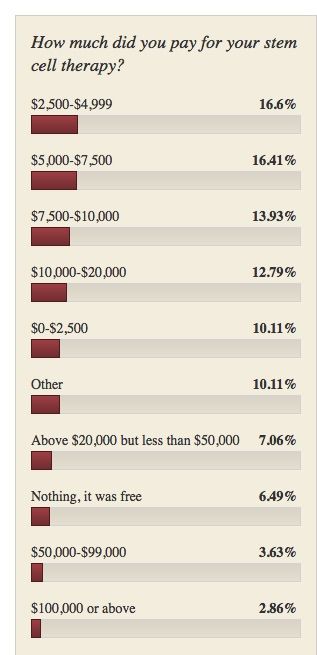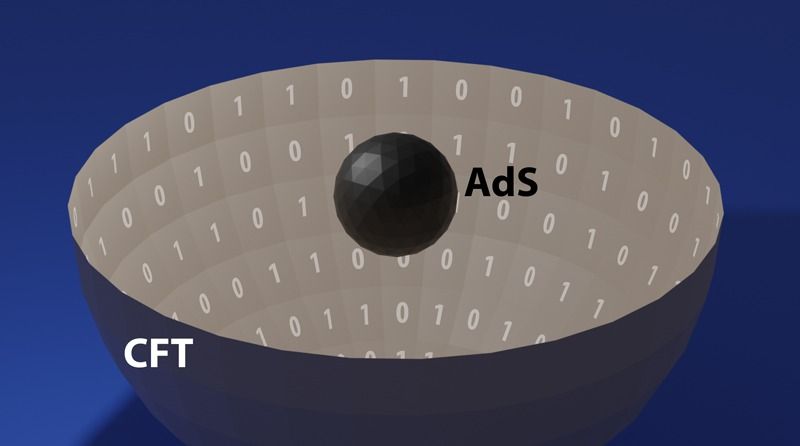Page 7428
May 21, 2020
Update on stem cell treatment cost for 2018 from ongoing poll
Posted by Lon Anderson in categories: biotech/medical, internet
The average cost of stem cell treatment is $8,750.
I get asked many questions about stem cell therapies, but one of the most common over the years has been about the stem cell treatment cost. For instance, a reporter might ask, “How much does a stem cell treatment for MS cost?” and a patient might ask me, “How much is a fair cost for a stem cell therapy for arthritis?” Or, patients will voluntarily tell me what they paid or mention it in the comments. We hear various numbers thrown around about costs so I decided to do a poll on this. I even did an early update on the results of this poll, voicing my skepticism that the costs paid were worth it.
But the poll has gotten well over 500 responses now so I thought I would revisit it and what it might mean.
Continue reading “Update on stem cell treatment cost for 2018 from ongoing poll” »
May 21, 2020
Magnetic core–shell nanowires as MRI contrast agents for cell tracking
Posted by Mike Diverde in categories: biotech/medical, nanotechnology, neuroscience, surveillance
Interesting articles on theranostic iron nanowires. I’m interested in watching all aspects of development of nanobots, because I think it may lead to new forms of treatments for superlongevity and superintelligence.
Phys.org: Iron nanorobots go undercover to do surveillance on living cells in real time:
https://phys.org/…/2020–05-iron-nanorobots-undercover-surve…
Continue reading “Magnetic core–shell nanowires as MRI contrast agents for cell tracking” »
May 21, 2020
Nabbing Criminals
Posted by Saúl Morales Rodriguéz in categories: biotech/medical, neuroscience

Upon seeing the blood-stained gloves, O.J. Simpson may have had electrical activity in his brain that showed recognition, and guilt.
May 21, 2020
Modified tattoo electrodes can be used to measure brain activity
Posted by Saúl Morales Rodriguéz in categories: neuroscience, physics
In 2015 Francesco Greco, head of the Laboratory of Applied Materials for Printed and Soft electronics (LAMPSe) at the Institute of Solid State Physics at Graz University of Technology, developed so-called “tattoo electrodes” together with Italian scientists.
These are conductive polymers that are printed using an inkjet printer on standard tattoo paper and then stuck to the skin like transfers to measure heart or muscle activity.
This type of electrode, optimized in 2018, opened up completely new paths in electrophysiological examinations, such as electrocardiography (ECG) or electromyography (EMG). Thanks to a thickness of 700 to 800 nanometres — that is about 100 times thinner than a human hair — the tattoos adapt to uneven skin and are hardly noticeable on the body.
May 21, 2020
Remote, brain region–specific control of choice behavior with ultrasonic waves
Posted by Saúl Morales Rodriguéz in categories: biotech/medical, neuroscience
The ability to modulate neural activity in specific brain circuits remotely and systematically could revolutionize studies of brain function and treatments of brain disorders. Sound waves of high frequencies (ultrasound) have shown promise in this respect, combining the ability to modulate neuronal activity with sharp spatial focus. Here, we show that the approach can have potent effects on choice behavior. Brief, low-intensity ultrasound pulses delivered noninvasively into specific brain regions of macaque monkeys influenced their decisions regarding which target to choose. The effects were substantial, leading to around a 2:1 bias in choices compared to the default balanced proportion. The effect presence and polarity was controlled by the specific target region. These results represent a critical step towards the ability to influence choice behavior noninvasively, enabling systematic investigations and treatments of brain circuits underlying disorders of choice.
Noninvasive and reversible modulation of neuronal activity in specific brain circuits may allow us to diagnose and treat brain disorders in, targeted ways. Low-intensity ultrasound, applied to the brain noninvasively, can be used to modulate neural activity with spatial specificity superior to other noninvasive methods such as transcranial electrical or magnetic stimulation (1–5). The neuromodulatory potential of ultrasound has been highlighted in studies that targeted peri-motor regions of anesthetized rodents or rabbits. Brief, low-intensity stimuli lead to observable movements of the limbs or other body parts (6–13).
However, the enthusiasm about the neuromodulatory potential of ultrasound has recently been dampened by studies that called these effects into question (14, 15). In addition, such overt effects have not been observed in large mammals including humans. Only small changes in neural signals (16–23) or small changes in reaction time or other metrics (24–26) have been found. Yet, to make it truly useful, the approach would ideally provide neuromodulatory effects that are strong enough to manifest in behavior. For example, if clinicians are to determine which brain circuits drive a patient’s craving for an addictive drug, the neuromodulatory effects on a particular neural circuit should be potent enough to yield measurable changes in the subject’s choice behavior, i.e., whether the subject decides to use the drug or not.
May 21, 2020
“Superpower” Discovered in Squids: They Can Massively Edit Their Own Genetics
Posted by Genevieve Klien in categories: biological, genetics, neuroscience
Revealing yet another super-power in the skillful squid, scientists have discovered that squid massively edit their own genetic instructions not only within the nucleus of their neurons, but also within the axon — the long, slender neural projections that transmit electrical impulses to other neurons. This is the first time that edits to genetic information have been observed outside of the nucleus of an animal cell.
The study, led by Isabel C. Vallecillo-Viejo and Joshua Rosenthal at the Marine Biological Laboratory (MBL), Woods Hole, is published this week in Nucleic Acids Research.
May 21, 2020
Producing Axions from Photon Collisions
Posted by Saúl Morales Rodriguéz in categories: cosmology, particle physics
The collision of two intense light beams may produce detectable signatures of dark matter particles called axions.
Axions—hypothetical particles that are much lighter than electrons—could hold the key to important physics puzzles, from the matter–antimatter asymmetry to the nature of dark matter. So far, the strongest constraints on their properties, such as their mass and how they couple to photons, come from astrophysical measurements that look for axions produced by photons interacting with magnetic fields inside the Sun. Now, Konstantin Beyer at the University of Oxford, UK, and colleagues propose a lab-scale experiment based on colliding intense laser beams. The researchers say that, for an important range of axion masses, their approach would be as sensitive as astrophysical searches but much less dependent on hard-to-test models of astrophysical axion-generation processes.
The team’s scheme is a variation of the “light-shining-through-a-wall” (LSW) method of axion detection. In LSW, axions created by a laser beam propagating in a magnetic field would be detected after passing through a wall that shields the detector from the laser photons. The team’s new scheme uses two laser beams, whose collision may produce axions through a light–light scattering process. After passing through the wall, the axions would be converted into detectable photons by a magnetic field.
May 21, 2020
A Microscopic Account of Black Hole Entropy
Posted by Saúl Morales Rodriguéz in categories: cosmology, particle physics, quantum physics
String theory provides a microscopic description of the entropy of certain theoretical black holes—an important step toward understanding black hole thermodynamics.
In the 1970’s, theorists determined that black holes have entropy [1], a remarkable finding that points at analogies between these spacetime singularities and systems of particles, such as classical gases. The crucial proof was provided by Stephen Hawking, who demonstrated, using a quantum-mechanical framework, that black holes radiate as if they were black bodies with a specific temperature [2]. The analogy was completed by extending all four laws of thermodynamics to black holes [3]. In thermodynamics, entropy is an important bridge between the macroscopic and the microscopic world: In a gas, for instance, entropy relates macroscopic heat transfer to the number of available microscopic states of the gas molecules. Providing a similar microscopic explanation of black hole entropy is an important test for theories that aim to unify gravity and quantum mechanics.
May 21, 2020
Dynamic Stimulation of Visual Cortex Produces Form Vision in Sighted and Blind Humans
Posted by Saúl Morales Rodriguéz in categories: biotech/medical, cyborgs, neuroscience
A visual cortical prosthesis (VCP) has long been proposed as a strategy for restoring useful vision to the blind, under the assumption that visual percepts of small spots of light produced with electrical stimulation of visual cortex (phosphenes) will combine into coherent percepts of visual forms, like pixels on a video screen. We tested an alternative strategy in which shapes were traced on the surface of visual cortex by stimulating electrodes in dynamic sequence. In both sighted and blind participants, dynamic stimulation enabled accurate recognition of letter shapes predicted by the brain’s spatial map of the visual world. Forms were presented and recognized rapidly by blind participants, up to 86 forms per minute. These findings demonstrate that a brain prosthetic can produce coherent percepts of visual forms.
















